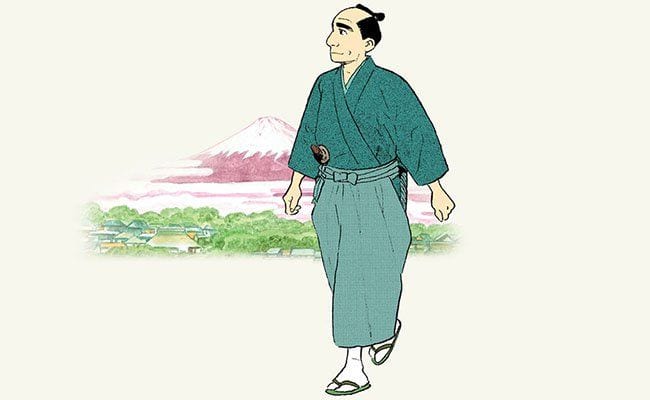
It doesn’t seem like much of a premise: a man walks around 18th-century Tokyo (which at that time was known as Edo).
Yet in the hands of manga master Jiro Taniguchi, this simple premise unfolds into a beautiful, deeply rewarding work. Nothing much actually happens in Furari: there’s no conflict or struggle, just steady walking and gentle dialogues amid a beautiful milieu of natural scenery and well-researched cultural backdrops.
Nonetheless, it leaves the reader with a feeling of contented fulfilment. The central character, a retired man who spends his days counting his steps around Edo, is loosely based on Ino Tadataka, the 18th century surveyor and cartographer who produced the first modern map of Japan. But the main protagonist in this book is not the narrator; it’s the beauty of 18th century Edo. The scenes are immaculately depicted and absolutely breathtaking in their beauty. The line drawings are simple and only a few pages feature colour.
Taniguchi — who died earlier this year –had an unparalleled ability to express his appreciation for nature in sweeping sketches that make your heart leap. His artistic style is a sort of maximalist minimalism: use of simple, unassuming line sketches, that possess an uncanny, almost magical ability to evoke the imagination as they come together, building and soaring into breathtaking splendour. Taniguchi used simplicity of detail to get at the innate majesty of the scenes he depicted.
Eighteenth century Edo gives him plenty of material to work with. The protagonist walks through burgeoning markets, passes by street performers, pauses for a dinner of sushi, goes cherry-blossom viewing with his wife. Taniguchi inserts interesting and well-researched little historical moments: releasing turtles bought from a temple as a way to gain spiritual points; a sumo wrestler who enacts a match for passers-by. And there’s plenty of eating: even then Edo was full of famous restaurants serving local specialities.
Taniguchi’s speciality has always been nature scenery. Even when his manga aspired to more complex plot narratives it always retained a certain gentle, contemplative aspect grounded in the natural beauty of its settings. This is true of his more fast-paced adventures — the five-part Summit of the Gods, for instance, portraying a mystery/thriller set in the Himalayas — as well as his more idea-focused fantasies, like the time-travelling tale A Distant Neighbourhood. No matter what the plot, genre or theme, it’s always the beautiful and natural backdrop that grabs the reader’s eye.

There’s plenty of that here. From vistas of Mount Fuji looming in the background, to the fields and mountains surrounding the city, Taniguchi finds ingenious opportunities to lead the viewer out of the city and into the broader natural landscape. There’s an element of magical realism in the narrative, with the central character frequently losing himself in dreamy reverie and transforming in his mind’s eye into the creatures around him: a cat, a dragonfly, even an ant. His brief dream-journeys depict both Edo and the landscape beyond from the perspective of these creatures.
Furari, which first appeared in Japan in 2012 and is now appearing for the first time in English translation, should be a quick read — dialogue is kept to a minimum — but what winds up taking time is the fact that the reader can’t help but be absorbed by the detail in almost every frame. Each frame of sweeping scenery and intricately sketched lines is worthy of study and reflection. The gentle pace of the story — the protagonist walking through ethereal clouds of fireflies; exchanging haiku with a poet by the riverside; drinking sake under cherry blossoms with his wife — turns the experience into a relaxing and pleasant one; the book is almost therapeutic in this regard. In an era dominated by fast-paced manga drama, Taniguchi’s Furari is a welcome demonstration of manga’s gentler side, and of the complex depths that can lie within gentle and retrospective contemplation of one’s surroundings.
Furari’s heartwarming beauty and gentle pace is certain to provoke a smile, and a deep sense of satisfaction. Its plot summary may not sound like much, but suffice it to say that this is one of the most rewarding manga to emerge this year.

